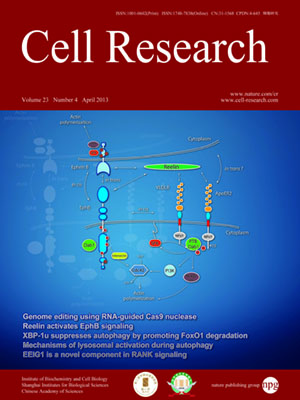
Volume 23, No 4, Apr 2013
ISSN: 1001-0602
EISSN: 1748-7838 2018
impact factor 17.848*
(Clarivate Analytics, 2019)
Volume 23 Issue 4, April 2013: 465-472
ORIGINAL ARTICLES
Genome editing with RNA-guided Cas9 nuclease in Zebrafish embryos
Nannan Chang1,3,*, Changhong Sun1,2,*, Lu Gao1,3, Dan Zhu2, Xiufei Xu2,Xiaojun Zhu1,3, Jing-Wei Xiong1,3 and Jianzhong Jeff Xi1,2
1Institute of Molecular Medicine, Peking University, Beijing 100871, China
2College of Engineering, Peking University, Beijing 100871, China
3State Key Laboratory of Natural and Biomimetic Drugs, Peking University, Beijing 100871, China
Correspondence: Jianzhong Xi, Jing-Wei Xiong(jzxi@pku.edu.cn; jingwei_xiong@pku.edu.cn)
Recent advances with the type II clustered regularly interspaced short palindromic repeats (CRISPR) system promise an improved approach to genome editing. However, the applicability and efficiency of this system in model organisms, such as zebrafish, are little studied. Here, we report that RNA-guided Cas9 nuclease efficiently facilitates genome editing in both mammalian cells and zebrafish embryos in a simple and robust manner. Over 35% of site-specific somatic mutations were found when specific Cas/gRNA was used to target either etsrp, gata4 or gata5 in zebrafish embryos in vivo. The Cas9/gRNA efficiently induced biallelic conversion of etsrp or gata5 in the resulting somatic cells, recapitulating their respective vessel phenotypes in etsrpy11 mutant embryos or cardia bifida phenotypes in fautm236a mutant embryos. Finally, we successfully achieved site-specific insertion of mloxP sequence induced by Cas9/gRNA system in zebrafish embryos. These results demonstrate that the Cas9/gRNA system has the potential of becoming a simple, robust and efficient reverse genetic tool for zebrafish and other model organisms. Together with other genome-engineering technologies, the Cas9 system is promising for applications in biology, agriculture, environmental studies and medicine.
Cell Research (2013) 23:465–472. doi:10.1038/cr.2013.45; published online 26 March 2013
FULL TEXT | PDF
Browse 2542


